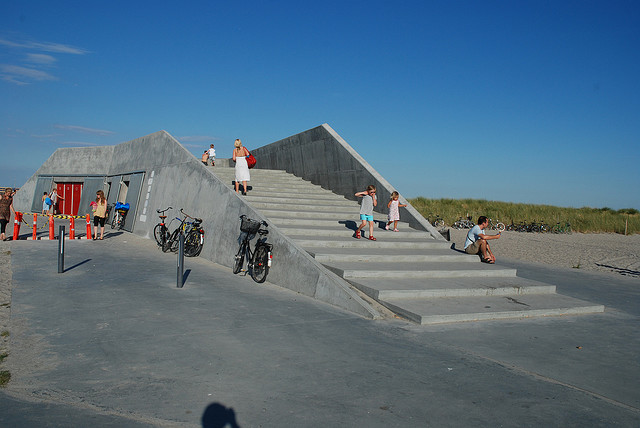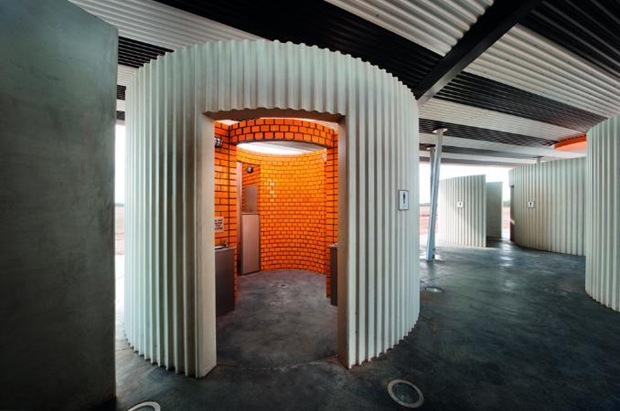
BOB, an inflatable cloud above a public bathroom and forum, the result of a pedagogical experiment involving graduate art and architecture students at Columbia University
According to the New York Post, the National 9/11 Memorial will open this year with no bathrooms. The $508 million project will draw legions of visitors and is characterized by gushing water, but anyone seeking a toilet will have to leave the site for a nearby department store.
This omission of public bathrooms resonates with a personal architectural experience. Over the past six months, I participated in a collaboration of art and architecture students to design a pavilion at Columbia University. It is located in a courtyard behind the architecture school and will be up for most of the summer. A temporary structure, a pavilion is often the architect’s opportunity to build without the inconvenience of plumbing or other practicalities.
By Adrian Coleman
Bucking the trend, our team eschewed highbrow inutility to design a public bathroom. Our mantra was an adapted Carl Andre quotation: A society that does not provide public bathrooms does not deserve public art. Columbia has almost no specified public bathrooms. By deploying a public bathroom in an academic courtyard, we wanted to recast a space of seclusion as open and engaged with the city.
What distinguished our design from most public bathrooms was its composting toilet. Because our design was temporary, we couldn’t connect to existing pipelines. A septic tank, as in a portable toilet, was also impractical because it required frequent emptying. A composting toilet is a waterless technology that breaks human waste into organic fertilizer.
Numerous community gardens in New York use this method because it requires little maintenance, produces a useful product, and is astonishingly unsmelly. Sewer gases are the product of anaerobic digestion, which takes place in a wet system with little oxygen. Composting toilets, through sawdust and a continuous airstream, dry and oxygenate the tank to enable aerobic digestion. Microbes decompose matter efficiently. Instead of manufacturing sulfate or methane gases, the composting toilet produces soil-enriching nitrates and nitrites.
In our proposal, the fan-assisted ventilation of the tank also pressurized a large inflatable canopy. This balloon signified the bathroom from a distance. It represented its sphere of influence. We enjoyed the idea that something as taboo as the toilet could support a whimsical and highly visible thought-bubble.
Alas, the reality of architecture is that few projects are realized as they are designed. Sometimes the powers-that-be are not interested in experimentation. Columbia Facilities reviewed our proposal early in the semester and expressed sufficient approval such that plans for ordering the composting toilet began during Spring Break. However, during April, with construction under way, Facilities informed us that the composting toilet was not permitted. They raised concerns about the smell of the bathroom, the legality of the installation, and the possibility of a leak. In response, our team put together a lengthy document to address each of their concerns. We included a letter from the manufacturer that verified the toilet would neither smell nor leak and that our installation scheme was consistent with manual specifications. We included passages of code to indicate our proposal was within the boundaries of the law. We also included a contingency plan so that in the unlikely case of a leak, a hazardous waste company could remove the toilet and decontaminate the site within twelve hours.
Facilities was unmoved. Next, they claimed our composting toilet had been used in recreational or residential situations but not an academic courtyard. It would require six months of testing prior to installation. The reasoning was finicky, but we realized no matter how we argued our case, Facilities was determined to block the composting toilet.
Ultimately, we completed our pavilion with the composting toilet for display purposes only. Named Bob for its gentle undulation, the balloon hangs above the non-functional bathroom and is in inflated by an electric fan separate from the composting system. Although our pavilion does not operate as we wished, we hope the diagram of our intention endures.
For many of us, Bob is the first built project in which we were principal designers. The process was inspiring, frustrating, and eye-opening. I am proud of our pavilion, but our non-functional bathroom remains a lost opportunity. That Columbia University found our public bathroom threatening perhaps confirms its urban disengagement. That the City of New York and Columbia University both found public bathrooms to be extraneous or unjustified suggests a broader theme. Our society is invested in the photogenic image of architecture but not the gritty infrastructure to facilitate collective experience.
As a young architect interested in more than art museums, I hope to challenge this trend throughout my career.
Adrian Coleman is a graduate architecture student at Columbia’s Graduate School of Architecture, Preservation, and Planning. Directed by Professors Galia Solomonoff, Liam Gillick, and Nathan Carter, he and other students designed Bob the Pavilion, which will host various events through the summer of 2011.































